Photo

THE MISSION OF THE STUDENTS IS TO CREATE MEMORABLE TOUR EXPERIENCES AND DISCOVER THE WONDERS OF THE CHURCHES AND STATUES THROUGH SAFE AND RELIABLE TOUR
0 notes
Photo

Student’s Tour in Manila
Start date: January 10, 2019 Number of Students: 4
End date: January 13, 2019
The students of Colegio de San Juan de Letran is in the tour in the span of 4 days. Before the tour starts they’ll take a minute to make familiarize with the said location in Churches and Statues with brief safety precautions and regards to their rules and regulations always go after the itinerary given. All churches are located in Manila, these churches stand out for their history and beautiful architecture. The churches are revered for their old-school architecture that is like no other and style that is ahead of their time. While all the Statues are filled with very rich history and each statue has a behind fascinating stories.
0 notes
Photo
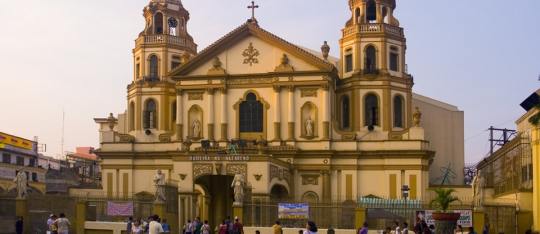
QUIAPO CHURCH
On their first day of the tour, at exactly 7:00 am in the morning, the students is fully ready to go on their first destination “one of manila’s best known landmarks” which is Quiapo Church or Minor Basilica of the Black Nazarene, located at the Quezon Blvd, Metro Manila
The students arrived at 8:00 am in the church and they roam around to take some pictures and they go inside to offer a simple prayer
At 8:30 am, they started to discuss about the Quiapo Church that it is a 1933 replacement of an older structure destroyed by the fire. The best take away with this church is Quiapo is the home of the Black Nazarene. The students realized that it’s an image of Christ believed to be miraculous. The life-size statue, carved from ebony, was first brought to Quiapo in 1767.
It is one of the favourite Visita Iglesia destinations not only because of the devotion site and being the heart of manila. Quiapo Church has a lot of major renovations in the past due to calamities and wars. The church still has a original Baroque Style Architecture. It can also notice that Quiapo Church’s façade with twisted columns on both levels. The Corinthian columns of the second level has a third of its shaft twisted, while the upper portion has a smooth surface. Quiapo Church holds a novena every Friday, and called Quiapo Day, in honour of the Black Nazarene, and there are a lot of devotee’s attendees. Also, the men who have panata are devoted to carry the Black Nazarene statue around a specific route and a sign of a vow to serve the Lord in this sacrifice
A recommendation told them that If people do decide to take a taxi going to quiapo church, always make sure that negotiate a price first before riding a taxi
At 10:00 am in the morning, the students had their early lunch at seafood palace near the quiapo also they are preparing for their next destination.
0 notes
Photo
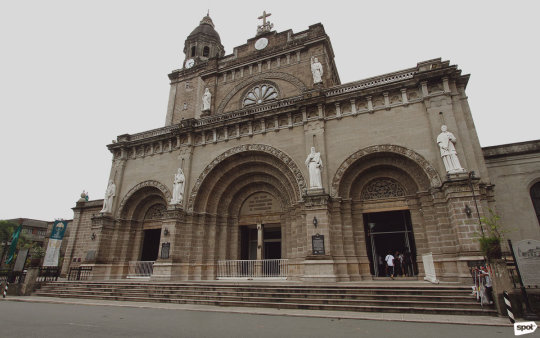
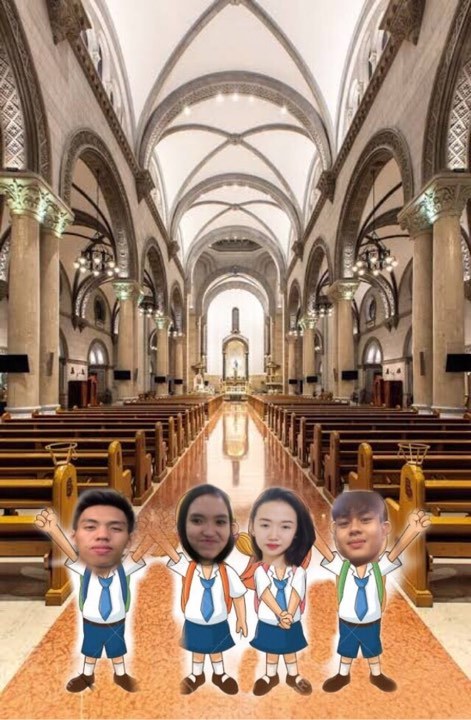
MANILA CATHEDRAL
On their second tour at 11:00 in the morning, the students are prepared to go to “Mother Church in the Philippines” and it is Manila Cathedral church. The era of western church architecture in the Philippines During the three centuries of colonization it produced grandly design churches; one of these is the Manila Cathedral.
At 12:00 in the afternoon, they arrived safely at Manila Cathedral
They discussed about The story of the Manila Cathedral that it is not only a story of the Church; it is also a story of the Intramuros and a story of the Philippines. It is one of the oldest and most famous churches in Asia. To preserve the church the leaders of the Philippine church set a lot of renovations and restorations. Also, take note that they decided not to restoration, did not involve improving tot the overall look of the church but also modernizing the look. Over the last four centuries, the church has been crushed to the ground by a lot of situations including wars and earthquakes a total of seven times. But God’s will, the church continues to rise from the ashes. The people believed that if the church can fall a lot of times and can rise again, well the Filipinos also can rise again.
It is not only about the church, but also a symbol of the community and a faith. Manila Cathedral also has a religious artworks and relics of popes and saints like the other churches, and also it was a great idea that the church serves as resting place for the remains of former archbishops in Manila.
They noticed that there are a lot of vendors outside the church selling icecream, rosary and bracelet
They left the church at 1:00 in the afternoon
0 notes
Photo

OUR LADY OF THE ABANDONED PARISH IN STA. ANA
On their third destination for first day of the students is the Our Lady of the Abandoned Parish in Sta. Ana. Before they head out to the church, they visited one of their groupmate's house who is just living nearby the church. They took their snacks there and take a little rest.
At exactly 1:40 pm they visited the church that is just a walking distance away from their groupmate's house.
The parish was established by the Franciscan missionaries in 1578 under the patronage of Saint Anne. The construction took five years to finish, with the total cost of ₱ 33,000 including the donation of the Governor General amounting to four thousand pesos
In the early 1700s, Fr. Inglés went to Valencia, Spain. The friar had been very enamored of a famous image of Our Lady that had become a popular spiritual attraction in Valencia. The image was known as the Our Lady of the Abandoned. While Fr. Inglés was in Valencia, in the year 1713 he decided to have a copy of this image for Santa Ana Parish, which was in the process of being constructed near Manila. After reverently touching the copy to the original image, the friar brought the new replica image with him to the Philippines in 1717.
*The image has been venerated in Santa Ana since then. In time, the parish became known as Our Lady of the Abandoned Parish, as it is today, though St. Anne still is honored in the church with a statue of her with the child Mary in a niche directly above the image of Our Lady of the Abandoned.
The church structure follows the Baroque architectural style, utilizing adobe blocks in its wall surface finish to give an impression of massiveness.
The church facade is divided into three levels by heavily molded string courses. The topmost level or the pediment is adorned with Vitruvian-scroll design on its raking cornice, and a central niche flanked with octagonal windows.
0 notes
Photo


MINOR BASILICA OF ST LORENZO RUIZ
On the first day of the tour at 7:00 am in the morning the students have arrived to a decision to visit a church and it is the Minor Basilica of St. Lorenzo Ruiz or what many knows the Binondo Church.
They have planned to go there after their vacant and Binondo Church was not far from their school the Colegio De San Juan De Letran. The Binondo church or the Minor Basilica of St. Lorenzo Ruiz was formerly known as the Our Lady of the Most Holy Rosary Parish. The church is being administered by a Dominican priest, Binondo is known as China town home of many Chinese people residing in the Philippines. The Minor Basilica of St. Lorenzo Ruiz was purpose established there to serve Chinese whom converted to Catholicism. The Minor Basilica of St. Lorenzo we see today is not the original church established in 1596 because it was bombarded by the British.
As a renovation after the Second World War a new material was used to make the new church and this time with a new design and it is a western façade inspired during at that period in time.
According to the history the patron of Binondo, Church which is San Lorenzo Ruiz has a Chinese father and a Filipina mother but that did not stop him from renouncing his Catholicism faith and was later renowned by Pope John Paul II. The students have observed the solemn environment of the church; even though not all residing Chinese in Binondo is a Catholic they still give respect to the church. Binondo gives life to a Chinese tradition and culture but they still give importance to the Binondo church. The students have also learned aside from its unique displacement of the church, also one of our heroes during Spanish Colonization Andres Bonifacio was married in Binondo Church with Gregoria De Jesus. When the students entered the church they cannot deny the fact but the Sistene Chapel, the ceiling murals are quite something and worth seeing
What the students was disappointed was the fact that location of the church is a bit dirty and you can see around the corners beggars are asking for food or even worst residing around the church. It is also little bit noisy especially during midday due to the vendor around the area. The students found out that the style of the church was mainly influenced by Chinese traditions such as, bilateral symmetry, use of enclosed open spaces, the incorporation of ideas related to feng shui such as directional hierarchies, a horizontal emphasis, and the allusion to various cosmological, mythological, or other symbolisms. The shape only uses geometric shapes such as square, circle and triangle there were very limited natural shapes found on the church.
Regarding on the Form and Texture since it was refurbished a longtime ago you identify its vintage materials used. The Church was also balanced which is symmetry in form because there were no protruding materials in the area. Patterns were widely used in this architectural design because of the repletion of waves, spiral and grids was used, overall the unity of the church fits the theme of it.
0 notes
Photo

SAN AGUSTIN CHURCH
On the Second destination of the Second day is the students have finallydecided and ready to go to San Agustin Church
At exactly 9:30 in the morning they arrived at the church
The San Agustin Church was beneath the auspices of the Agustinian Order. The friars took the cudgels in building the church. Like many constructions during that time, the church of San Agustin was built with the use of nipa and bamboo. The constructing of the church started out in 1571, it was once then formally named as Iglesia y Convento de San Pablo. In 1574, the Chinese pirate, Limahong invaded Manila
The invasion led to the burning of the city and the San Agustin Church used to be no longer spared. This led to the first reconstruction of the church a yr later. The second church was once made of wooden materials. Because of the choice of the structural fabric used, it remained unstable to fireplace accidents. True enough, every other fireplace brought about the destruction of the church in 1583. The Augustinian friars made positive now not to commit the identical mistakes and so they determined to build the new church the use of adobe stones. In 1586, they appointed Juan Macias to lead the sketch and building of the church. It used to be solely in 1607 that the announcement of its reputable completion was made
The structure persisted even on the strongest earthquake that hit Manila from the 16th to 17th century. The solely most important broken that the San Agustin persevered used to be the cave in of one of the church’s bell tower, which was once then completely removed therafter. Because of the church's age, it has emerge as a witness to many sizeable activities in Philippine history for the duration of the Spanish period. In 1762, in the course of the Seven Year’s War, British forces looted the church. In 1898, the church grew to be a venue for American and Spaniards to discuss and signal the lay down of Manila to the Americans
Today, its contribution to nationhood will always be embedded in the records of our country.
The students observed the church and they said that it was Sedate and direct to the point, the facade follows the style of High Renaissance. The symmetrical composition is prefixed by means of pairs of Tuscan columns that flank the most important door of the two-tiered facade. The vertical movement of the paired columns is adapted at the second degree via equally paired Corinthian columns. At the 2nd level, mass and void alternate in a simple rhythm of stable partitions and windows. The two levels, emphasized by using horizontal cornices, are then capped with the aid of a pediment that is accentuated with a easy rose window
The facade’s hard composition is held together via two towers; unfortunately, the missing left belfry in addition exaggerates the lackluster facade. It used to be taken down after a destructive earthquake hit the church in 1863 and 1880, splitting the tower in two.
The facade has a touch of Baroque by the ornately carved timber doorways that depict floras and spiritual images. Baroque is also evident in the carved niches that quietly live between the paired lower columns.
They offer a simple prayer inside the church and after that the students left the church at 10:40 am in the morning
0 notes
Photo

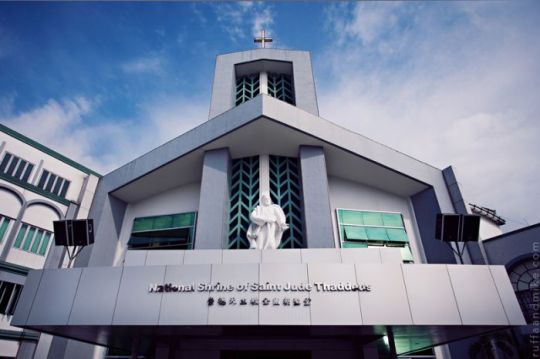
NATIONAL SHRINE OF ST JUDE THADDEUS
On the Third Destination of their Third day is the students is ready to go to The National Shrine of Saint Jude Thaddeus or Saint Jude Parish (originally recognised as Espíritu Santo Chinese Parish), is one of three Chinese parishes installed by way of the Roman Catholic Archdiocese of Manila in Metro Manila, Philippines
They arrived at their destination at 11:30 in the morning
The shrine holds its novena service each and every Thursday to Saint Jude, whose traditional coloration is green. Its annual fiesta is held each October 28, the Feast of Saints Jude Thaddeus and Simon the Zealot. The shrine is popular with college students and these reviewing for board examinations, as Jude Thaddeus is considered the consumer saint of hopeless cases
The first corporation mounted via Fr. Henry Windges, SVD in 1955 used to be the Praesidium Marias Spes Sinensium of the Legion of Mary. With the placing up of the parish council, other organizations followed: Filipino-Chinese Catholic Youth, Altar Servers, Catholic Women's League, St. Jude Foundation, Kerygma Lectors, Ichtys Choir, Mother Butler's Guild, St. Jude Ladies' Association, Pax Et Bonum Choir, Special Ministers for the Holy Communion, Couples for Christ, the Greeters and Collectors Ministry, and the Friends of St.Jude
The church has a area or v formed format due to present residential establishment before the construction took place. the altar as the foremost component of the church is positioned at the middle of the region and the seats have been radiating from the core which can make the customers focal point their imaginative and prescient to the altar. the format structure of the church make a contribution to acoustical elements of the seal. the church has a contemporary style which is evident on its facade because in the course of the development in the late 50s and early 60s, present day style architecture was once a fashion and a pragmatic style. the surfaces of the faced used to be concrete however due to the slow deterioration of the building, the surfaces were cover with cladding to enhance the aesthetic aspect of the church.
0 notes
Photo

At the end of their Churches Tour, the next two days are all about Statues Tour
0 notes
Photo


PEOPLE POWER MONUMENT
It was in the Third day of the First tour when the students of Colegio De San Juan De Letran agreed to visit the said place. The students started as early as 7:00 am in the morning because the location of the monument is a long way of us and consist of 2 hours travel time depending on the traffic situation. One of the chosen itineraries of the students of the Colegio De San De Letran is the People power Monument
The people power monument is located in the busy streets of EDSA White plains Avenue, Quezon City, It was built to commemorate the courageous hearts that flock together in the street to bring down the tyrant Former President Ferdinand Marcos Upon reaching the area of the People Power Monument they notice the solemn ambiance of the area making it a great place for relaxation. A person passing by and within the area really gives respect to the monument, for an instance the place is very well maintained they did not saw any graffiti on the monument. They did not also saw any beggar scattered in the area, garbage’s are also properly thrown in the designated place.
Upon observing the monument by the students they notice the different artistry applied especially with its styles and technique. ��Several principles had been applied for the monument to become a successful piece of art, and first thing that the students noticed is how the Balance had been used. If you will notice there is a One man standing on top of the other individuals on the bottom tier and pointing something not too far, even though it seems to be distorted they have managed to put symmetry on the monument by making both sides having the same elements and position
Next to it that the students observe is the Emphasis, as I have said earlier that there is man standing on the man and women in the bottom tier the artist wants to attract the attention of the viewer to the man on top which serves as a symbol for the leadership of Ninoy Benigno to ignite the war to the dictator Former President Marcos. Lastly is the Unity because the students felt like the artist done a great job in unifying all the themes in the monument. In similar the students also observed how the elements of the arts were applied; using the form and shape they applied a combination of geometric and natural shapes to form the monument. Texture can also be noticed because the materials used were made sure to stand for a long period in time. On how the spaces were managed they have able to attain positive and negative space to the people on the bottom tier of the monument. Still the students have learned an important lesson the monument is more than just any tourist destination or piece of art for it symbolizes a big chunk in part of the history of the Philippines especially of the darkest time of the Philippines. The monument also serves as a ground for protester every year to gather and condemn the killings of the Martial Law.
0 notes
Photo


Monument of Jose Rizal
At the second tour in their third day, at exactly 10:00 am in the morning, the students are fully ready to go the “Most popular, most visited, most guarded and most photographed monument” is the Monument of Jose Rizal in Luneta. Incase everyone is not aware, The original title of Rizal Monument is Motto Stella) or “guiding star” Given by its designer Swiss sculptor, Richard Kissling.
At 11:30 am in the morning, the students arrived at Luneta Park and discussed about Rizal have died fighting for the freedom of the Philippines. Jose Rizal is our national hero. A lot of people in the other parts of the world admired him.
Jose Rizal’s Monument is not only built with the precious metal and stone, but his house also remains. The students of Colegio De San Juan De Letran know how to give an honor and respect to this important landmark in the Philippines
The students observing the Monument they notice it is composed of a standing bronze sculpture of Rizal, with an obelisk as his backdrop, set on a granite stone base which his remains are interred inside. The students also notice how high this monument is, the height of the monument is 12.7 meters or 42 feet.
Next to it, the students observe the monument in Luneta portrays Rizal in overcoat holding a book that represents his novels Noli Me Tángere and El filibusterismo. The obelisk is commonly understood as Rizal’s masonic background while the three stars stand for Luzon, Visayas and Mindanao.
At 1:00 am in the afternoon, the students ended their second destination for third day and they are getting ready for their next destination
1 note
·
View note
Photo


Lapu Lapu Monument
On the Third day of the third tour the students have decided to visit the Lapu Lapu monument or the statue of the sentinel of freedom found in Rizal park, Luneta specifically in the Agrifina Circle
The students have agreed to visit it on the last day of the tour since it was not to far from Colegio De San De Letran. The Statue has a height of 12.19 meters or 40 ft (including the 3.05 meters or 10 ft pedestal) and the material mainly used was bronze making it solidified as ever and capable of standing for a period of time.
The students was confused on why the Lapu Lapu monument was established in Rizal park since they know the lapu lapu and Magellan confrontation happened in Cebu for their clarification it was a gift of the korea Freedom League to the Filipino people because Lapu Lapu was the first Asian whom fought against a foreign invasion. They also learned that the statue was built in Rizal park because the idea was to make the Luneta enclosed to the two heroes whom fought for the country against foreign invaders and it was our very own Dr. Jose Rizal and Lapu Lapu. On the statue you can see that Lapu Lapu is standing holding is Kampilan (sword) it is used to convey hero's face conveys strength and determination but with such great kindness and a stance that exudes power and vigilance. In addition the statue also shows Lapu-Lapu as a strong and peace loving but at the same time ready to defend himself against those who trample on his cherished freedom.
Upon strolling around the area the students have noticed the peacefulness and the cleanliness of the area. Since it is establish in the open air of Rizal Park you can feel the fresh breeze of the air and the silence of the area since it Is far from the busy streets of Manila. About cleanliness there is also a street sweepers roaming around the area to make sure that garbage’s would not be disposed everywhere.
After strolling the area we noticed that elements and principles of design has been applied to make the statue ravishing. The students noticed that the form and texture of the statue was well furnished making the texture smooth and there is no unfinished material to the statue given to the fact that it is made of bronze. The statue is well balanced for same the elements and postion has been applied there are no protruding material from the statue.
The students also found the emphasis on part on the Kampilan of Lapu Lapu showing the strength and courage of Lapu Lapu. The statue of Lapu Lapu maybe simple, no ornaments or distinguishable materials was shown but the simpleness makes it unique and unified to one.
0 notes
Photo
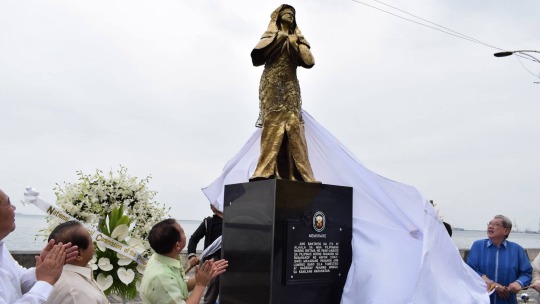

FILIPINA COMFORT WOMEN
On their first destination of the Fourth day the students have decided to visit the Filipina Comfort Women at exactly 7:00 am in the morning.
At 8:00 in the morning, the students arrived at their destination and they were really amazed by the surroundings of the monument
The Filipina Comfort Women was a statue publicly displayed along Baywalk, Roxas Boulevard in Manila. Unveiled on December 8, 2017 and installed through the National Historical Commission of the Philippines (NHCP) and other donors and foundations,
it was dedicated to the Filipino "comfort women", who were coerced into sexual slavery by the Imperial Japanese Army during World War II.
The statue consists of a bronze statue designed by Jonas Roces and a historical marker installed by the NHCP.The statue took three months to complete.
The students notice how bronze statue is and have two meters tall, depicting a representation of an estimated 1,000 Filipinas who have undergone sexual slavery during World War II. It depicts a grieving blindfolded woman in traditional Maria Clara attire.The pedestal features the historical marker on its front, while its back cites the effort and donations of groups and individuals.
When the students saw at the back of the statue is a small plaque, with the title of the statue as "Filipina Comfort Women" and the name of its designer.
Roces has insisted that the statue is not made as means to protest against either the government of Japan and the Philippines but as a "reminder" of Philippine history that he wanted future generations not to forget
The students left the monument at 10:00 in the morning and getting ready to their next destination
0 notes



